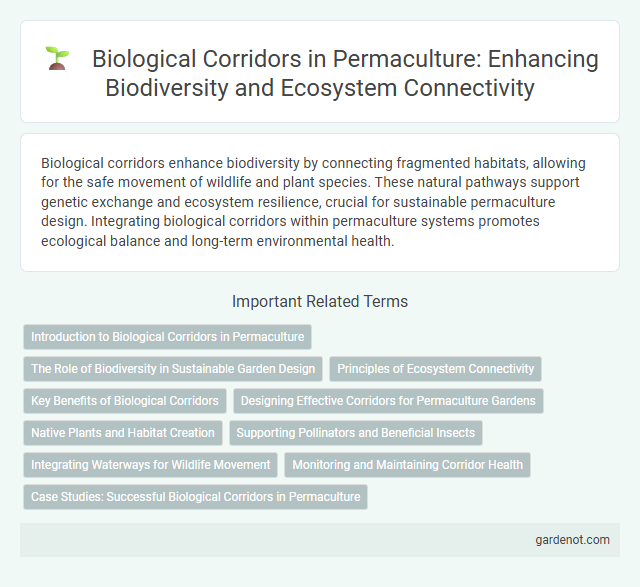Biological corridors enhance biodiversity by connecting fragmented habitats, allowing for the safe movement of wildlife and plant species. These natural pathways support genetic exchange and ecosystem resilience, crucial for sustainable permaculture design. Integrating biological corridors within permaculture systems promotes ecological balance and long-term environmental health.
Introduction to Biological Corridors in Permaculture
Biological corridors in permaculture are strategically designed pathways that connect fragmented habitats, enhancing biodiversity and ecosystem resilience. These corridors enable the migration, dispersal, and genetic exchange of wildlife, promoting sustainable ecological balance within agricultural and natural landscapes. Integrating native vegetation and natural features into corridor design supports pollinators, pest control species, and soil health, making biological corridors essential for permaculture systems.
The Role of Biodiversity in Sustainable Garden Design
Biological corridors enhance permaculture by connecting fragmented habitats, facilitating species migration and genetic exchange essential for ecosystem resilience. Integrating diverse plant species within these corridors supports pollinators and natural pest control, fostering a balanced garden ecosystem. Sustainable garden design leverages biodiversity to improve soil health, water retention, and microclimate regulation, promoting long-term productivity and ecological harmony.
Principles of Ecosystem Connectivity
Biological corridors maintain ecosystem connectivity by facilitating wildlife movement and gene flow between fragmented habitats, crucial for biodiversity preservation and resilience. These corridors enhance ecological processes such as pollination, seed dispersal, and species migration, supporting natural succession within permaculture designs. Implementing biological corridors aligns with permaculture principles by promoting habitat diversity, nutrient cycling, and sustainable ecosystem interactions.
Key Benefits of Biological Corridors
Biological corridors enhance biodiversity by connecting fragmented habitats, allowing species to migrate, breed, and access diverse resources crucial for ecosystem resilience. These corridors facilitate genetic exchange, reducing inbreeding and increasing population viability, which is vital for long-term species survival. Furthermore, biological corridors support ecosystem services such as pollination, pest control, and climate regulation, directly benefiting permaculture systems and surrounding landscapes.
Designing Effective Corridors for Permaculture Gardens
Designing effective biological corridors in permaculture gardens enhances biodiversity by connecting fragmented habitats, allowing pollinators and beneficial insects to thrive. Incorporating native plants, diverse layers of vegetation, and water sources creates functional pathways that support wildlife movement and ecological balance. Strategic placement of these corridors optimizes ecosystem services such as pest control, soil regeneration, and habitat resilience.
Native Plants and Habitat Creation
Biological corridors utilizing native plants enhance ecosystem connectivity by providing essential habitats for local wildlife, promoting biodiversity and resilience. Native species improve soil health, support pollinators, and create sustainable living spaces for fauna, facilitating natural migration and gene flow. Integrating these corridors into permaculture design strengthens habitat networks and fosters long-term environmental stability.
Supporting Pollinators and Beneficial Insects
Biological corridors in permaculture design create continuous habitats that support pollinators and beneficial insects by providing diverse flowering plants and shelter throughout the year. These corridors enhance biodiversity, improve pollination rates, and contribute to natural pest control, promoting a balanced ecosystem. Integrating native plant species within these corridors ensures optimal nourishment and habitat for crucial insect populations essential for sustainable agriculture.
Integrating Waterways for Wildlife Movement
Designing biological corridors within permaculture systems enhances biodiversity by connecting fragmented habitats through natural waterways. Integrating rivers, streams, and wetlands allows wildlife to migrate safely, supports aquatic ecosystems, and promotes genetic diversity. Strategic planting of native vegetation along water edges stabilizes banks, filters pollutants, and provides crucial habitat for numerous species.
Monitoring and Maintaining Corridor Health
Monitoring and maintaining the health of biological corridors involves regular biodiversity assessments and habitat quality evaluations to ensure species connectivity and ecosystem stability. Utilizing remote sensing technology and field surveys helps detect changes in vegetation cover, invasive species presence, and signs of habitat degradation. Implementing adaptive management strategies based on continuous data collection supports the restoration and resilience of permaculture landscapes within corridors.
Case Studies: Successful Biological Corridors in Permaculture
Successful biological corridors in permaculture, such as the Mesoamerican Biological Corridor and Costa Rica's Guanacaste Corridor, demonstrate enhanced biodiversity connectivity and ecosystem resilience. These corridors facilitate species migration, pollination, and genetic exchange by linking fragmented habitats within permaculture landscapes. Empirical studies reveal increased soil health, pest control, and crop yields, highlighting their critical role in sustainable agricultural systems.
Biological corridor Infographic

 gardenot.com
gardenot.com